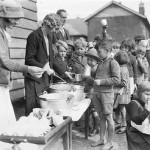Last week, I had the absolute pleasure of chaperoning the annual multi-day field trip for the sophomore class. In an effort to bring to life some of the key concepts about civil rights the kids were learning in their humanities class, we decided to take them to Los Angeles.
At the Japanese American National Museum, the kids were spellbound as they watched a documentary about the Japanese internment that took place just after WWII and then got a tour from a gentleman whose father was imprisoned at Manzanar. At the Museum of Tolerance, the kids learned about the events that led up to and surrounded The Holocaust through an amazing interactive exhibit full of sound and light.
During one afternoon, we serendipitously stumbled upon Homeboy Industries, a non-profit organization dedicated to helping gang affiliated and previously incarcerated youth get back on their feet. My small group got a tour from Luis who, at the age of 14, had been abandoned by both of his parents, was dealing drugs in the projects, and was armed. His story was so moving, all they could do was listen, wide-eyed. You could hear a pin drop.
The sophomores are different than they were one week ago before the trip. They now know that the perceived gap between the evil nazis and what other nations are capable of doing isn't as wide as they had once thought.
They know that millions of ordinary people were killed just because of who they were, while the rest of the world turned a cold shoulder.
They know that once upon a time, criminals were children that had really hard lives and that they are still human beings who, with enough support, are able to turn things around.
This trip took four full days. During these four days we weren't solving math problems, reading challenging texts, or crafting organized essays. In short, none of the things that happened during those four days will ever show up on a value-added model graph. None of those experiences will "count" toward what we as educators were able to contribute to their lives this year.
Here are a few other things that won't show up in the graphs:
Before the trip,
•Hunter had never been camping.
•Jordan had never been away from home overnight.
•Stella had never had a peanut butter and jelly sandwich (she's from France).
•Amanda had never seen an ocean.
Tests are easy to graph. I'd like to find a psychometrician who can take the camping, the PB&J, and the Pacific Ocean and show how THOSE things have forever impacted the sophomores on their four-day trip.








